Courthouse of Tehran
Courthouse of Tehran (کاخِ دادگستریِ تهران – Kāx e Dādgostari ye Tehrān), is the historical courthouse of Tehran, the capital of Iran.
| Courthouse of Tehran Kāx e Dādgostari ye Tehrān (Persian) | |
|---|---|
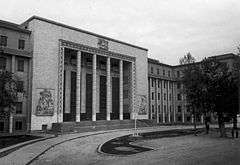 Courthouse of Tehran in 1970s | |
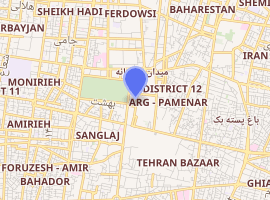
| |
| General information | |
| Architectural style | Neoclassical |
| Location | Tehran, Iran |
| Country | Iran |
| Coordinates | 35.6816°N 51.4189°E |
| Completed | 1946 |
| Design and construction | |
| Architect | Stanislav Sůva |
It was designed by Czechoslovak architect Stanislav Sůva, using neoclassical architecture. The Palace of the Justice in Tehran has been constructed during the time of the first intense boom in the modernisation of Iran which has touched all parts of the Live of Iranian nation lives during the reign of Reza Shah Pahlavi. In the Sphere of cultural events there has the up surge in large extent application also the sphere of architectonic creation. The building was built by the Czechoslovak-Iranian company S. I Skoda in Tehran between 1938 and 1946, as the construction was suspended for several years due to the World War II. With European companies came to the country also hundreds of specialists and could be mentioned that famous foreign firms, have their aim to delegate to Iran real experts, either that their reasons were to guarantee qualitative execution of big constructional works or erections which were in Iranian conditions very of quite complicated - either the reason was international reputation. Foreign firms have intensively collaborated with Iranian experts who were very scarce because Iranian universities and technical high schools could not educate experts for all the needs that in the country had arose. The decision to build the Palace of Justice could be dated by the year 1936 (Iranian era 1315)At South than had been created a new street. The building should have been designed for 1200 employees as for the Ministry of Justice as for the Law-court, criminal and civil court, as well - with necessary spaces which of them were from architectonic reasons the most important - entrance hall, the main hall for the Court, the hall, the dining room / restaurant (with the kitchen and accessories) and certain studies and rooms for the court. The architectonic view of the building he has elaborated at the principle of a little extended slender pillars of rectangular shape or only pilasters at the periphery of all facades which were supporting a light slab of the cornice. The fronts of the building were of similar type. At the beginning of November 1937 (Aban 1316) were the proposal of Dr. Czihal by the highest places refused. The situation became quite critical because the construction could not have been any longer postponed. It could be presumed that later on had arised an assumption that the creator of the Palace of the Justice was a German Architect. But Dr. Czihal was a Czechoslovak citizen with German nationality. In central office of Company S.I.Skoda in Tehran and their building department there was employed an young architect by Ing. Stanislav Sůva, who had with extraordinary success finished his studies at University of Architecture and Civil Engineering in Prague and who had already in July 1937 (Tir 1316) independently at the work of Mr Czihal elaborated a sketch for the front face of the building of palace of the Justice in "European monumental conception". It is not known if the sketches were presented to the Ministry. After rejection of previous conception was asked the Ing. Arch. Sůva to elaborate his architectonic concept (for the lay-out given to him and for the building volume as mentioned above) in the most shortest time. At the same time there were asked also other Tehran’s architects Mr. Nikolai Markov , Mr. Minache ( Mr. Minache was French nationality.) and also Mr.L.Fischer to prepare also their proposals. All proposals were presented on December 1937 (Azar 1316) to the Minister of Justice. The proposal of architect Sůva was selected in this competition as victorious and the architect was asked to elaborate with small changes final proposal for the front face of the building and such drawings were presented to His Majesty the Emperor. The concept was approved by highest places on January 8th 1938 and this was the end of the struggle for suitable aesthetic solution for the palace of Justice at which competition was present a number of architects. The creator for the Palace of Justice was aware of the neighborhood of historic building Golestan Palace which exclude the possibility to select for the Palace of Justice any international way of architecture for utilitarian and constructivist view. It was necessary that the architecture had in its surrounding a contemporary character but at the same time in Iranian style which is intelligible to Iranian people but freed from excessive archaism, at the other side the forms have to have a permanent value. The designs for skirting parts had been elaborated under leading of architect Mr. Suva by architect Mr.Tiyvoran the other lining and embossing parts by architects Mr. Kopp and Mr. Jan Gabriel. It has to be mentioned that not only stone-dressing works but also other craftsman's works which were done by many Iranian workers managed by tenths of Czech experts , mistries, engineers are given the evidence that the aim all of them was to create a constructional work of national renaissance in Iran. During the year 1940 was the creator, architect Suva called to return to Prague - at the time already occupied by German Nazis. He refused and was employed in the constructional department of the Ministry of finance and later on had collaborated with the architect Mr. M. Foroughi at the design of the building for the ministry of finance. Ing. Arch. Jan Gabriel who worked out different architectural details like on front facade face, design of PJ entrance door, and ceiling stucco in the interiors) Ing. Arch. Jan Gabriel was working before it on completion project of Shah Opera, and after PJ, on Shah Spa in Balborsán
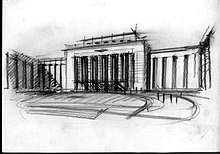
Today, High Council of the Judiciary is based in this building.
Gallery
 Justice bas relief author by Stanislav Sůva; Sculptor Lajoš Biró
Justice bas relief author by Stanislav Sůva; Sculptor Lajoš Biró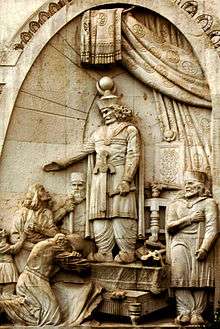 Statue of Anushirawan the Just by Qolam Reza Rahimzade Arzhang
Statue of Anushirawan the Just by Qolam Reza Rahimzade Arzhang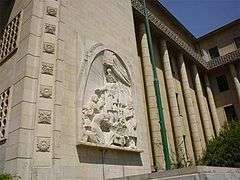 View from the side
View from the side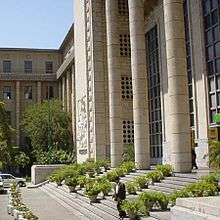 View of the front part
View of the front part
References
Czech document about Czechoslovak workers in Iran